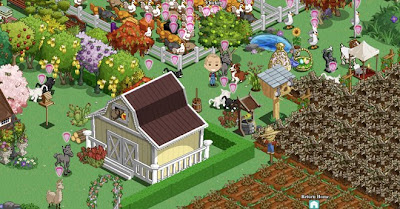What is the game which is played by 1% of world population every month?
That's right, welcome to FarmVille with population 82.4 million players (as for May 2010). Some 30 millions of them check their crops daily.
This mean that 20% of all Facebook users login FarmVille every month to plant, tend and harvest virtual crops, over and over and over again. And folks from the company behind the game, Zynga, say that it's only the beginning - and they already released iPhone app, showed in most recent Steve Jobs presentation.
Wow, I am not really a big gamer geek (regardless of what you all think, I only play Scrabble on iPad recently). But it is still fascinating for me - what is the key to the success of this shit-graphic, repetitive and extremely simplified game that looks like rip-off from early Nintendo adventure games?
There are a number of factors here, all purely hypothetical and only based on surveys rather than well controlled studies.
First - social factor - if a player persuades their Facebook friends to become their FarmVille "neighbours", they can be rewarded for fertilizing their friends' fields or feeding their hogs.
Playing games like FarmVille is “intimate, yet public.” You can publish your accomplishments to your Facebook Wall for all to see, in case you want your friends to know that you’ve mastered the art of farming strawberries or won a blue ribbon for your prize eggplants. Obviously, this is something that non-invasively keep people in touch as well - a phenomenon I call 'ping communication' - when you don't actually exchange any particular information with your social contact online, but rather virtually 'poke' each other, or send invite for some stupid quiz or send a pig to friend in FarmVille.
What's more, FarmVille mechanics is based on the oldest action-reward idea in the gaming history, borrowed from old Chinese games, which are in turn based on old Japanese RPG games. You have control, you make an action, which will have predictable result. You don't make an action on time, and your crop will die. So you have to come back to the game after a while when you leave the Facebook to maintain your farm. Simple.
And it's extremely simple to play as well. Almost every age group from teenagers to older players can set up their own virtual farm within couple of minutes. Simple diagonal layout borrowed from those old Japanese games combined with straightforward options menu, and minimalist iconic graphics, makes the game learning process almost instant. And the fact that you have to get back to the game regularly, works like a virtual pet, a Tamagotchi - you have to nurture it and look after it every day, otherwise it will be sad and will die soon after.
We can add more theories to it, like an urban fantasy of having farm, but at the end of the day, it seems that FarmVille is a masterpiece of simple combination of all the things we already know in gaming - simplicity of interface, control, predictability, direct action-reward model and social networking. All those aspects shifter social online gaming to the mainstream. Today's average social online game player is 43-year-old women and generally housewives staying with kids at home. But FarmVille population covers all group ages, which is absolutely unprecedented phenomenon.
It also looks like Zynga reported a revenue of over $200mln in 2009 and FarmVille is definitely one of their key product. It's a good figure, but not as much as you would think. There are no exact numbers on how many users actually spend money, but it looks like only a small percentage of users do so. To put it in the context - Blizzard, with biggest online MMORPG game World of Warcraft (population of ONLY 11.5 millions - 8 times smaller than FV), gets an average profits of $100mln PER MONTH. Console games producers also report much more profits than Zynga.
But Zynga strategy of keeping it simple and continuously expanding FV universe by a small elements keeps users logged in for a long time. Ultimately, they seem to learn well from other games producers and combine best features to keep you attached to your farm, so the future... might be interesting ;-)
[photo credit: Wired.com, Wikipedia, Zynga]









